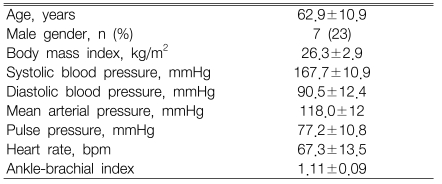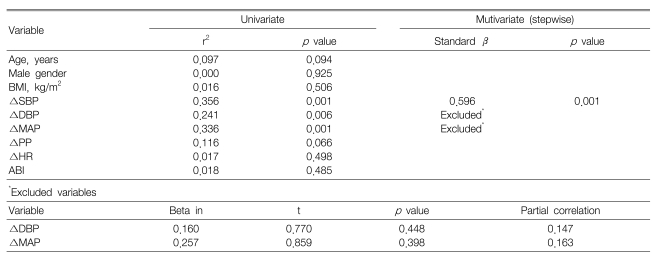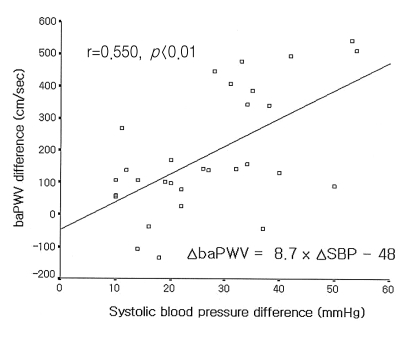Abstract
Background
The brachial-ankle pulse wave velocity (baPWV) is a useful parameter to assess arterial stiffness. However, it is difficult to evaluate arterial stiffness in hypertensive patients because the baPWV is affected by the blood pressure itself. This study was designed to estimate the relationship between the change of the blood pressure parameters and the baPWV (ΔbaPWV) when hypertensive patients were subjected to an acute reduction of blood pressure.
Methods
Thirty patients with essential hypertension and whose blood pressure was higher than 140/90 mmHg were enrolled. In all the patients, the blood pressure and baPWV were measured using an automatic waveform analyzer with the patients at a resting state. When the reduction of blood pressure was more than 10 mmHg after sublingual administration of nifedipine 10 mg, then the blood pressure and baPWV were measured again in the same manner and then they were compared with the baseline values. Spearman's correlation and multiple linear regression tests were performed to estimate the relationship between the change of the blood pressure parameters (ΔSBP, ΔDBP, ΔMAP and ΔPP) and the ΔbaPWV.
Results
The baPWV was significantly decreased shortly after the administration of nifedipine (1903.6±305.2 cm/sec vs. 1716±252.0 cm/sec, respectively, p<0.01). The ΔbaPWV was correlated with the ΔSBP (r=0.550, p<0.01), ΔDBP (r=0.386, p<0.05), ΔMAP (r=0.441, p<0.05), and ΔPP (r=0.442. p<0.05). On the multiple regression analysis, the ΔSBP was the only significant variable for predicting the ΔbaPWV, and the linear equation was ΔbaPWV=8.7×SBP-48.
Conclusions
The baPWV is affected by the systolic blood pressure level to a large degree and careful attention must be paid to the blood pressure level when evaluating arterial stiffness with using the baPWV.
Keywords: Arterial stiffness, Pulse wave velocity, Blood pressure, Hypertension
INTRODUCTION
Pulse wave velocity is a noninvasive parameter that's used to evaluate arterial stiffness and it is an independent predictor of the risk for cardiovascular disease1-4). A new device that can simply measure the PWV by simultaneous oscillometric measurement of the pulse wave in all four extremities (brachial-ankle pulse wave velocity, baPWV) has recently been developed. This method is fairly reproducible and it is well correlated with the conventional central PWV5-9). The baPWV, which was confirmed in large clinical trials as a parameter of arterial stiffness, is a useful screening method for evaluating the atherosclerotic risk10-14).
Age, gender and blood pressure are the major determinants of the PWV1, 6-8, 14-16). Among these, blood pressure is affected by various conditions such as the surrounding environment, emotional stress and/or physical activities. Although attempts to correct the baPWV via the blood pressure have been done in several studies in order to estimate the absolute risk of atherosclerotic cardiovascular diseases1, 6, 16-18), there is currently no data about the effects of acute changes of the blood pressure on the baPWV in one subject. In the present study, we evaluated the relationship between the change of several blood pressure parameters and the baPWV with an acute reduction of blood pressure after the administration of sublingual nifedipine.
MATERIALS AND METHODS
Subjects
The total of 30 consecutive subjects were recruited from those patients who were newly diagnosed with essential hypertension and whose blood pressure was higher than 140/90 mmHg. The medical history and symptoms of each subject were confirmed by the consulting doctor. All the subjects had a normal ankle-brachial index (ABI >0.9) and they were without any medical history of diabetes mellitus or renal insufficiency.
Methods
The baseline blood pressure and baPWV were measured in all the patients with using a volume-plethysmographic apparatus (PWV/ABI, Colin Co. Ltd.). This instrument can simultaneously record profiles of several variables such as the PWV, the blood pressure parameters (systolic blood pressure, diastolic blood pressure, mean arterial pressure and pulse pressure), the heart rate and the ABI. Nifedipine 10 mg was administered sublingually to all the patients and the blood pressure was measured every 10 minutes. When the reduction of the blood pressure was more than 10 mmHg, then the same profiles were rechecked for making comparison with the values measured before and after the administration of nifedipine. If the systolic blood pressure did not fall by more than 10 mmHg for 30 minutes, then sublingual nifedipine 10mg was administered once more. All the procedures were supervised by doctors who monitored the subjects' signs and symptoms and their blood pressure.
Statistics
The data was expressed as means±SDs. Statistical analysis was performed using the SPSS 11.5 software program. The changes of the blood pressure parameters (ΔSBP, ΔDBP, ΔMAP and ΔPP), heart rate (ΔHR), and the baPWV (ΔbaPWV) between before and after the administration of nifedipine were evaluated by using the non-parametric Wilcoxon Signed Rank test. Spearman's Rho correlation test was performed to evaluate the relationships among the changes of the blood pressure parameters, the heart rate and the baPWV. Univariate and multiple linear regression tests (the stepwise method) were also performed to estimate the association between the change of the blood pressure parameters and that of the baPWV. A p value below 0.05 was considered statistically significant.
RESULTS
The clinical characteristics and hemodynamic parameters of the subjects are shown in Table 1. The subjects' mean age was 62.9±10.9 years and 7 of the 30 patients were male. Table 2 depicts the change of the blood pressure parameters, the heart rate and the baPWV after administration of nifedipine. All of the blood pressure parameters and the baPWV were acutely decreased for a brief period of time and in contrast, the heart rate was significantly increased. In 30 patients, the mean change of systolic blood pressure was 27±13 mmHg and that of the baPWV was 187±189 cm/sec. The ΔSBP, ΔDBP, ΔMAP and ΔPP between before and after the administration of nifedipine were well correlated with the ΔbaPWV, but the ΔHR was not correlated with the ΔbaPWV (Table 3). On univariate linear regression analysis, the ΔSBP, ΔDBP and ΔMAP were the significant variables for predicting the ΔbaPWV. However, the ΔDBP and ΔMAP showed weak partial correlation with the ΔbaPWV if the ΔbaPWV was adjusted by the ΔSBP, and then these 2 factors were excluded because of their statistical insignificance on the multiple linear regression analysis by the stepwise method (Table 4). Finally, the linear equation was acquired as ΔbaPWV=8.7×ΔSBP-48 (Figure 1).
Table 1.
The baseline characteristics and hemodynamic parameters of the enrolled hypertensive patients (n=30)
Table 2.
Comparison of the hemodynamic parameters and the baPWV between before and after administration of nifedipine
Δ, difference between before and after the administration of nifedipine; SBP, systolic blood pressure; DBP, diastolic blood pressure; MAP, mean arterial pressure; PP, pulse pressure: HR, heart rate: baPWV, brachial-ankle pulse wave velocity
Table 3.
Correlation coefficients (r): Correlations between the change in the baPWV and the hemodynamic parameters
Δ, difference between before and after the administration of nifedipine; SBP, systolic blood pressure; DBP, diastolic blood pressure; MAP, mean arterial pressure; PP, pulse pressure: HR, heart rate; baPWV, brachial-ankle pulse wave velocity. **p<0.01, *p<0.05.
Table 4.
Univariate and multivariate regression analysis to predict the change of the baPWV
Figure 1.
Correlation between the change of systolic blood pressure and the baPWV.
DISCUSSION
Age, gender and systolic blood pressure are known to be the major determinants of the baPWV1, 6-8, 14-16). In a previous study, the baPWV was lower in females than in males until the age of 60 and it became similar in both genders over the age of 60. The relationship between age and baPWV demonstrated a quadratic curve for both genders15). Blood pressure, which is both changeable and modifiable, is also a major determinant of the baPWV for evaluating the arterial stiffness. The blood pressure is affected by various conditions such as the surrounding environment, emotional stress and/or physical activities. Therefore, it is difficult to discriminate whether the measured baPWV reflects only an elevated blood pressure or it increases the potential risk for atherosclerotic cardiovascular disease, and especially in those patients with high blood pressure. In other words, the baPWV may under- or overestimate the real potential risk for atherosclerotic cardiovascular disease if it is not corrected by the blood pressure level. There have been several studies that attempted to correct the PWV in patients by altering their blood pressure. Asmar et al1) reported on a simple linear equation to obtain the carotid-femoral PWV, and this equation was derived from the systolic blood pressure and age. Kubo et al6) also reported a regression equation that was derived from the mean systolic pressure and age by gender. Yamashina et al studied 5302 subjects with either normal blood pressure or with high blood pressure and they were without other atherosclerotic risk factors, and these researchers created a nomogram of the relation of the baPWV with blood pressure and then applied it to 297 subjects with coronary heart disease16). Yet there have been no studies about the changes of baPWV in one subject when there is an acute reduction of blood pressure. The present study confirmed that the difference of systolic blood pressure between before and shortly after the administration of nifedipine was positively correlated with the change of the baPWV. We believed that there were no changes in the conditions when measuring the baPWV except for the blood pressure. This fact may suggest that the baPWV is a reflection of the blood pressure to a large degree. Using multiple linear regression analysis, we also acquired a linear equation that can quantify the relation between the change of systolic blood pressure and the baPWV. This relationship might be useful to calibrate the change of blood pressure, especially when assessing the efficacy of antihypertensive agents for treating arterial stiffness.
The findings of our study have to be interpreted in light of the following limitation. First, we used the calcium channel blocker nifedipine (10 mg), which had an influence on the PWV by lowering the blood pressure through a vasodilatory effect. However, there are various types of antihypertensive drugs that have different mechanisms to lower blood pressure and they have different effects on the baPWV. We didn't compare the acute effect of blood pressure on the baPWV according to the types of antihypertensive drugs. Second, because the linear equation was acquired in a study that examined only 30 hypertensive patients, a larger sample size may be needed to validate and strengthen the statistical power of the equation.
In this study, we concluded that the baPWV is affected by the systolic blood pressure level to a large degree, and careful attention must be paid to the blood pressure level when evaluating arterial stiffness with using the baPWV.
References
- 1.Asmar R, Bentos A, Topouchian J, Laurent P, Pannier B, Brisac AM, Target R, Levy BI. Assessment of arterial distensibility by automatic pulse wave velocity measurement: validation and clinical application studies. Hypertension. 1995;26:485–490. doi: 10.1161/01.hyp.26.3.485. [DOI] [PubMed] [Google Scholar]
- 2.Laurent S, Boutouyrie P, Asmar R, Gautier I, Laloux B, Guize L, Ducimetiere P, Benetos A. Aortic stiffness is an independent predictor of all-cause and cardiovascular mortality in hypertensive patients. Hypertension. 2001;37:1236–1241. doi: 10.1161/01.hyp.37.5.1236. [DOI] [PubMed] [Google Scholar]
- 3.Blacher J, Guerin AP, Pannier B, Marchais SJ, Safar ME, London GM. Impact of aortic stiffness on survival in end-stage renal disease. Circulation. 1999;99:2434–2439. doi: 10.1161/01.cir.99.18.2434. [DOI] [PubMed] [Google Scholar]
- 4.van Popele NM, Grobbee DE, Bots ML, Asmar R, Topouchian J, Reneman RS, Hoeks AP, van der Kuip DA, Hofman A, Witteman JC. Association between arterial stiffness and atherosclerosis. Stroke. 2001;32:454–460. doi: 10.1161/01.str.32.2.454. [DOI] [PubMed] [Google Scholar]
- 5.Yamashina A, Tomiyama H, Takeda K, Tsuda H, Arai T, Hirose K, Koji Y, Hori S, Yamamoto Y. Validity, reproducibility and clinical significance of noninvasive brachial-ankle pulse wave velocity measurement. Hypertens Res. 2002;25:359–364. doi: 10.1291/hypres.25.359. [DOI] [PubMed] [Google Scholar]
- 6.Kubo T, Miyata M, Minagoe S, Setoyama S, Maruyama I, Tei C. A simple oscillometric technique for determining new indices of arterial distensibility. Hypertens Res. 2002;25:351–358. doi: 10.1291/hypres.25.351. [DOI] [PubMed] [Google Scholar]
- 7.Munakata M, Ito N, Nunokawa T, Yosinaga K. Utility of automated brachial ankle pulse wave velocity measurements in hypertensive patients. Am J Hypertens. 2003;16:653–657. doi: 10.1016/s0895-7061(03)00918-x. [DOI] [PubMed] [Google Scholar]
- 8.Matsui Y, Kario K, Ishikawa J, Eguchi K, Hoshide S, Shimada K. Reproducibility of arterial stiffness indices (pulse wave velocity and augmentation index) simultaneously assessed by automated pulse wave analysis and their associated risk factors in essential hypertensive patients. Hypertens Res. 2004;27:851–857. doi: 10.1291/hypres.27.851. [DOI] [PubMed] [Google Scholar]
- 9.Cortez-Cooper MY, Supak JA, Tanaka H. A new device for automatic measurements of arterial stiffness and ankle-brachial index. Am J Cardiol. 2003;91:1519–1522. doi: 10.1016/s0002-9149(03)00416-8. [DOI] [PubMed] [Google Scholar]
- 10.Takami T, Shigemasa M. Efficacy of various antihypertensive agents as evaluated by indices of vascular stiffness in elderly hypertensive patients. Hypertens Res. 2003;26:609–614. doi: 10.1291/hypres.26.609. [DOI] [PubMed] [Google Scholar]
- 11.Ichihara A, Hayashi M, Koura Y, Tada Y, Hirota N, Saruta T. Long-term effects of intensive blood pressure lowering on arterial wall stiffness in hypertensive patients. Am J Hypertens. 2003;16:959–965. doi: 10.1016/s0895-7061(03)01004-5. [DOI] [PubMed] [Google Scholar]
- 12.Munakata M, Nagasaki A, Nunokawa T, Sakuma T, Kato H, Yoshinaga K, Toyota T. Effects of valsartan and nifedipine coat-core on systemic arterial stiffness in hypertensive patients. Am J Hypertens. 2004;17:1050–1055. doi: 10.1016/j.amjhyper.2004.06.028. [DOI] [PubMed] [Google Scholar]
- 13.Uchida H, Nakamura Y, Kaihara M, Sugimoto T, Norii H, Sasaki M, Sato H, Makino H. Practical efficacy of telmisartan for decreasing morning home blood pressure and pulse wave velocity in patients with mild-to-moderate hypertension. Hypertens Res. 2004;27:545–550. doi: 10.1291/hypres.27.545. [DOI] [PubMed] [Google Scholar]
- 14.Chuang SY, Chen CH, Cheng CM, Chou P. Combined use of brachial-ankle pulse wave velocity and ankle-brachial index for fast assessment of arteriosclerosis and atherosclerosis in a community. Int J Cardiol. 2005;98:99–105. doi: 10.1016/j.ijcard.2004.01.019. [DOI] [PubMed] [Google Scholar]
- 15.Tomiyama H, Yamashina A, Arai T, Hirose K, Koji Y, Chikamori T, Hori S, Yamamoto Y, Doba N, Hinohara S. Influences of age and gender on results of noninvasive brachial-ankle pulse wave velocity measurement-a survey of 12517 subjects. Atherosclerosis. 2003;166:303–309. doi: 10.1016/s0021-9150(02)00332-5. [DOI] [PubMed] [Google Scholar]
- 16.Yamashima A, Tomiyama H, Arai T, Koji Y, Yambe M, Motobe H, Glunizia Z, Yamamoto Y, Hori S. Nomogram of the relation of brachial-ankle pulse wave velocity with blood pressure. Hypertens Res. 2003;26:801–806. doi: 10.1291/hypres.26.801. [DOI] [PubMed] [Google Scholar]
- 17.Yambe T, Yoshizawa M, Saijo Y, Yamaguchi T, Shibata M, Konno S, Nitta S, Kuwayama T. Brachio-ankle pulse wave velocity and cardio-ankle vascular index (CAVI) Biomed Pharmacother. 2004;58(Suppl 1):S95–S98. doi: 10.1016/s0753-3322(04)80015-5. [DOI] [PubMed] [Google Scholar]
- 18.Shirai K, Utino J, Otsuka K, Takata M. A novel blood pressure-independent arterial wall stiffness parameter: cardio-ankle vascular index (CAVI) J Atheroscler Thromb. 2006;13:101–107. doi: 10.5551/jat.13.101. [DOI] [PubMed] [Google Scholar]






